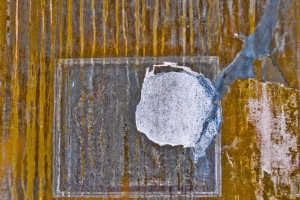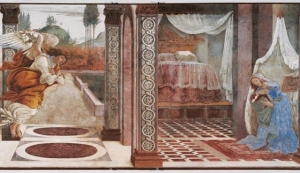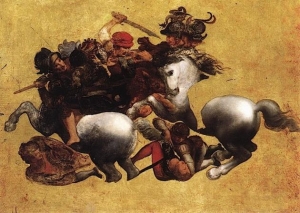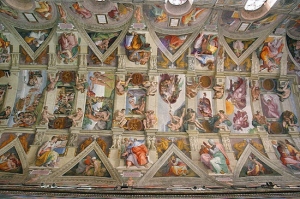|
Displaying items by tag: fresco
After an act of 'so-called' restoration akin to the horrors of 'Ecce Homo' - a mural depicting Christ with a crown of thorns, became an internet sensation when it was disfigured by Seniora Gimenez, while she attempted to restore it. The 120-year-old fresco had been transformed into something which resembled a character from "Planet of the Apes" - according to Turkish media, the country's culture ministry is investigating reports that a number of valuable Roman mosaics were badly damaged during botched restoration at an archaeological museum.
The Skowhegan School of Painting and Sculpture, which offers a nine-week summer residency for artists in Skowhegan, Maine, opened a permanent New York space on 18 November. The new Chelsea-neighborhood location features two floors and 5,000 sq ft. of space, half of which will be devoted to archives and event space.
The artists Daniel Bozhkov and Mary Mattingly, both alumni, were due to finish a site-specific fresco and an “edible forest garden,” according to the school.
A street in a small town in Italy bears the name of a British officer who risked court martial to save a Renaissance masterpiece from shelling in the Second World War.
Yet, Italian art experts have become so worried about the state of the 15th-century fresco dubbed “the greatest picture in the world”, that they have embarked on a major restoration project.
The work was only made possible with a hefty donation from a private citizen.
Piero della Francesca’s "The Resurrection," on display in Sansepolcro in north-east Tuscany, is widely hailed as one of the masterpieces of late 15th-century Italian art.
High above the altar in the Vatican's Sistine Chapel, the halo around Jesus Christ's head in Michelangelo's famous frescoes shines with a brighter glow, thanks to a revolutionary new lighting system.
Angels, sybils and prophets in blues, pinks and golds, once lost in the gloom, are brought into sharp relief by 7,000 LED lamps designed specifically for the prized chapel, where red-hatted cardinals have elected new popes since the 15th century.
A state of the art ventilation system has also been installed to protect the frescoes from humidity, enabling up to 2,000 people at a time to safely visit one of the world's top tourist attractions, which draws over six million people a year.

Last week, it was discovered that part of a fresco was missing from the ancient Roman city of Pompeii. It is believed that thieves broke into a closed-off section of the UNESCO World Heritage site and chiseled off a portion of the fresco bearing a depiction of the Greek goddess Artemis.
Police have launched an investigation into the disappearance of the eight-inch wide fragment. They will be reviewing surveillance footage from the perimeter of the site in hopes of identifying the thieves, but there are no security cameras within the ruins.
Professor Umberto Pappalardo, an archaeological expert at the Suor Orsola Benincasa University in Naples, told AFP he believes petty criminals were behind the theft, rather than art thieves aiming to sell the fragment on the international market. Pappalardo added, “Selling a stolen fresco from a site as well documented as Pompeii would be a very, very tall order. There would certainly not be any market for it in Italy.”
In January, a fragment of fresco was taken from another part of Pompeii and sent to the curator’s office in an anonymous package. Pompeii, one of Italy's main tourist attractions, has become a symbol for decades of mismanagement of the country's cultural sites. Italy's new Culture Minister, Dario Franceschini, has promised to increase maintenance work at Pompeii.

Earlier this month Italy’s Culture Ministry said that it would delay the loan of Sandro Botticelli’s The Annunciation of San Martino alla Scala (1481) to the Israel Museum because the timing was “not appropriate.” Following the announcement, Israeli Culture Minister Limor Livnat did all she could to assure her Italian counterpart that there was no danger in the artwork going on view in Israel. While many speculated that Italy’s decision to delay the loan was due to conflict in Syria, museum officials claimed that conservation issues were to blame for the near postponement.
Ultimately, on Tuesday, September 17, 2013, the work went on view at the Israel Museum as planned. The Annunciation is a large fresco that was originally painted on a hospital wall in Florence. After suffering significant damage, it was removed in 1920 and transferred to the Uffizi Gallery, where it underwent restoration. James Snyder, the Israel Museum’s director, said that the work has a deep connection to the Holy Land since the annunciation story took place in Nazareth, and “the landscape in the fresco is the landscape of this ancient land.”
The loan is part of celebrations in honor of Israel’s 65th anniversary.
Amid Syria fears, Italy’s culture ministry in Rome announced that it will delay its loan of a famous 15th-century painting by Sandro Botticelli to Israel because the timing is “not appropriate.” The Renaissance masterpiece The Annunciation of San Martino alla Scala was supposed to be sent to the Israel Museum in Jerusalem for inclusion in an exhibition opening on September 17, 2013.
The culture ministry said that it would send another painting of equal cultural and artistic content. The Uffizi Gallery organized the loan as part of celebrations for Israel’s 65th anniversary.
The Annunciation is a large fresco that was originally painted on a hospital wall in Florence. It was removed in 1920 and transferred to the Uffizi, where it underwent restoration.

A division of the Italian police department that specializes in art thefts has located a 400-year-old copy of a lost Leonardo da Vinci fresco. Depicting the Battle of Anghiari, the masterpiece was never finished.
The copy, widely known as the Tavola Doria, once adorned a wall of Florence’s city hall, the Palazzo Vecchio, and illustrates a historic battle between Florence and Milan that took place in 1440. It is believed that da Vinci experimented with various fresco-painting techniques before he started work on the battle scene in 1503. Despite his efforts, the paints began to drip and da Vinci was never able to finish the fresco. Over the next few years, the piece deteriorated and the Italian painter, Giorgio Vasari, was commissioned to paint over what was left of the incomplete fresco.
Since the unfinished da Vinci painting no longer exists, copies of the lost artwork are extremely important to art historians and scholars. This particular copy, painted on a small wooden panel, was last seen in public 73 years ago at a Leonardo da Vinci exhibition held in Milan on the eve of World War II. After the exhibition, the work disappeared.
Experts have since determined that the panel was stolen from its owners in Naples and ended up in the hands of a Swiss art dealer. The work was sent to Germany for restoration in the 1960s, made a brief appearance in the 1970s at an art gallery in New York, and by the 1990s was the property of a wealthy Japanese art collector.
Finally back in Italy, the Tavola Doria will be on view at Florence’s Uffizi Gallery during 2013. The work will then spend four years in Japan as part of a loan agreement worked out with the Fuji Art Museum in Tokyo, where it was last exhibited.

The 500-years-old Sistine Chapel is the most visited room in the world. Around five million people a year flock to Rome to see Michelangelo’s ceiling frescoes, one of the wonders of Western civilization. After the Sistine Chapel ‘s 500th birthday this past Wednesday, the Vatican warned that they might need to limit the number of visitors in order to protect the masterpiece.
Completed on October 31,1512 after four years of work by Michelangelo, the Sistine Chapel has never ceased to awe visitors and has become one of the most famous images in art history. The irreplaceability of the Sistine Chapel has many critics asking the Vatican to enforce limitations on the number of visitors per year. However, Antonio Paolucci, the director of the Vatican Museums, says he doesn’t foresee that happening anytime in the near future. He did admit that it might be a necessary measure further on down the road.
The dust, humidity, and carbon monoxide produced by visitors could possibly damage Michelangelo’s frescoes in the long term. In 1994, a 14-year restoration project that included an elaborate dehumidifying system, air conditioners, filters, and micro-climate controls was completed. However, the number of visitors to the Chapel continues to grow, putting the system under increasing stress. Paolucci is currently looking into newer technologies that will prevent the Vatican from having to limit the number of visitors to the Sistine Chapel.
n what appears to be one art lover's grassroots attempt to restore Elias Garcia Martinez’s fresco “Ecce Homo” in the Sanctuary of the town of Borja's Mercy Church near Zaragoza, Spain, a retiree took out her paint brushes and all but obliterated the over 100-year-old depiction of Jesus. The results are art historically disastrous, and such is the furor over the mishap that Guardian art critic Jonathan Jones suggested today, tongue firmly in cheek, that Borja's amateur art restorer be hired by other localities with worthy artworks that needed some international attention. It has to be mentioned, however, that the updated monkey-like Christ has a freakish new power all its own, and may be its own kind of metaphor for modern man.
|
|
|
|
|